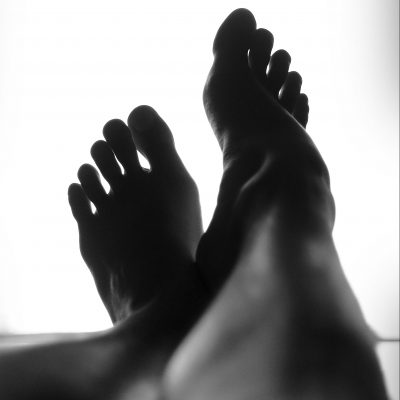Numbness and tingling in the feet during exercise is a fairly common complaint I have come across during my years of treating patients. There are multiple etiologies for numbness, some of which are benign, and others that may indicate a more serious underlying issue. In this article we will focus on some of the causes of numbness and tingling and several factors that can be modified to alleviate these complaints.
Some common words used to describe pain related to nerve injuries include:
- Numbness
- Tingling
- Burning
- Electric Shock
- Freezing
- Pins and Needles
In addition, sometimes nerve pain can cause a sensation that is out of proportion to the amount of pressure or stimulation applied to an area. For example, when you lightly touch your skin, you know you are being touched, but it should not feel painful. When the nerves in the area you are touching are damaged, the light touch can actually stimulate a painful sensation.
One of the most common causes of foot pain and numbness during exercise is due to poorly fitting shoes or socks that are to bulky. The easiest fix is to have your shoe wear evaluated by a medical professional or even a specialty shoe store. If you are wearing shoes with a toe box that is too small or have stiff shoes with an exceptionally high arch support these might be the causes for your pain. By getting proper fitting shoe-wear for your body type, you maybe able to completely eradicate your pain.
The nervous system has two parts, the central nervous system, and the peripheral nervous system. The central nervous system is composed of the brain and the spinal cord, and the peripheral nervous system is made up of all the peripheral nerves in the body found outside of the spinal cord. The nerves themselves are composed of two basic parts the axon and the myelin. The axon is like a wire that carries the information from one part of the body to another. The myelin is the covering outside the nerve, like the insulation of a wire. In a nerve injury, the axon, the myelin, or both can be damaged. The type of damage sustained by the nerve determines the symptoms that are present and the duration of the injury.
Pain in the foot can be due to compression, inflammation, or infection anywhere along the path of the nerve. Pain during exercise is most likely due to intermittent nerve compression. There are certain places in the body which are prone to nerve compression because of our anatomy and the tight spaces the nerves need to pass through. It is important to assess the areas of the foot that are numb because this can help to localize where the compression is occurring.
Morton’s Neuroma
One example of nerve compression is a Morton’s Neuroma. This is the result of compression, stretching, or repeated irritation of the interdigital nerve usually between the 2nd and 3rd or 3rd and 4th toes. It is more common in females than males, and is sometimes described as walking on marbles. Typically the pain radiates into the toes closest to the neuroma and the forefoot. The pain is usually intermittent in nature and can be alleviated by removing shoes. Often sneakers with small toe boxes “tight shoes” and high-heeled shoes aggravate the neuroma. It is also more common in people with tight calf muscles and very flat feet due to their body mechanics. It can be treated temporarily with a nerve injection into the foot. In addition, changing your shoe wear and possible use of shoe insert or pad may be helpful. Physical therapy may also be indicated. If physical therapy and conservative interventions fail, then surgical removal may be necessary.
Tarsal Tunnel Syndrome
Another reason for nerve compression is a condition called Tarsal Tunnel Syndrome. The tarsal tunnel is the canal formed between the inside of the ankle bone and a band of ligaments that stretch across the foot. The tibial nerve runs inside the tunnel and can get compressed. Pain and sensory disturbances due to tarsal tunnel syndrome is usually located in the bottom of the foot. Some causes for tarsal tunnel syndrome include, bony anatomy, ankle swelling (due to cardiac issues, inflammation, or injury), flat feet, arthritis or bone spurs. Non-surgical treatment options include, steroid injections, orthotics (braces, shoe inserts, and splints), anti-inflammatory medications and dietary modification (removal of inflammatory foods). If conservative treatments fail, a tarsal tunnel release may be indicated.
Common Peroneal Neuropathy
The common peroneal nerve can get compressed at the fibular head, which is the bony prominence just below the outside of the knee. If this happens, pain and numbness is present along the outside of the leg from the knee down into the top of the foot. The common peroneal nerve then further divides into two branches. If one of these branches gets compressed, the numbness and tingling will occur in a more specific distribution.
It is also possible for the nerves of the leg to become entrapped or compressed in the muscles of the back of the thigh, (i.e. Sciatica)or at the level of the spine (Disc Herniation, or Radiculopathy) . However with Sciatica and Radiculopathies the pain, numbness and tingling tend to include the leg as well as the foot.
Other mores systemic but common causes of foot numbness include, but are not limited to:
- Diabetes peripheral neuropathy
- B12 deficiency
- Disk Herniation
- Radiculopathy
- Vasculitis (inflammation of the blood vessels)
- Stroke (more likely if numbness is only on one side of the body)
- Raynauds phenomenon
As always, if you suffer from foot pain during exercise, it is a good idea to have it looked at by a health care professional.

